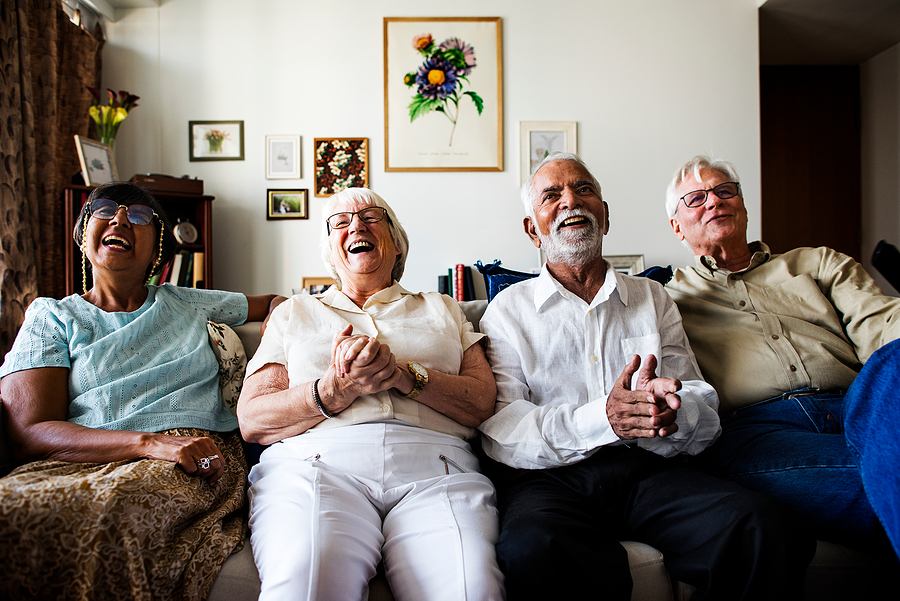Enhance Senior Living Residents’ Life Happiness with Better TV Programming Choices Explained
- On Apr, 02, 2024
- Jackie Nunez
- senior living tv programming

Let’s face it – traditional cable TV kind of sucks. It’s repetitive, boring, and with only a few dozen channels to flip through, it hardly gives residents enough variety to match their diverse interests.
But you can change it! Upgrading the television experience can vastly improve seniors’ quality of life by making it more engaging, accessible, and personalized.
Stop With the Tiny Buttons Already
One of the biggest issues with standard TV setups is that they simply aren’t designed for older users. The remotes have tiny, confusing buttons that are tough to press for arthritic hands. The on-screen menus use tiny text and cluttered layouts that are frustrating for anyone with vision issues.
And don’t get me started on the complex controls needed just to do basic functions like change the channel or adjust the volume. It’s downright humiliating and dignity-stripping when residents have to call staff for help with what should be simple tasks.
Thankfully, technology today offers TV systems tailored specifically for senior-friendly use. Simplified remotes use larger, well-spaced buttons, some even with enhanced grip textures. Voice control allows for completely hands-free operation – just say what you want to watch and make it happen! Streamlined on-screen menus with large text and clear organization enable residents to find their shows without assistance.
The goal is to maximize confidence and independence when interacting with the TV. Seniors should feel empowered to enjoy entertainment on their own terms.
Way More Options to Match Diverse Interests
Beyond ease of use, giving residents more entertainment options is key to engagement. And streaming services open up a world of possibilities! Instead of a few dozen channels, there is practically limitless content. Each senior can personalize their TV experience to match their unique interests.
Are they a sports nut who never misses a game? There are streams just for that. Prefer documentaries and educational programs? Endless options for lifelong learning!
Whether they love classic sitcoms from their younger years or new cooking shows or faith-based channels – it’s all available on demand. And closed captioning and audio descriptions accommodate those with hearing or vision difficulties, allowing everyone to participate. With so much variety, there is entertainment that thrills and inspires each individual. TV time becomes quality time when it’s actually shows they look forward to watching. The hours spent in front of the screen are more fulfilling and enjoyable.
Free Up Some Space
Let’s also talk about how upgrading TVs can open up physical space. Those giant, bulky consoles and boxy screens of old take up valuable real estate in common areas. But sleek, slim smart TVs mount flush to walls and open up floor space. Small streaming devices tuck away out of sight. Thoughtfully designed entertainment zones allow comfortable viewing stations while keeping rooms flexible for multiple uses.
Worth the Investment in the Long Run
Now upgrading technology does require some upfront budget, and expenses are always carefully weighed in long-term care. But improved everyday quality of life and satisfaction for residents is truly priceless. Keeping seniors constructively engaged with meaningful activity provides intellectual and emotional benefits beyond just “entertainment.” And residents who feel happy and active are also easier for caring staff to assist.
Plus, with television technology advancing, costs continue becoming more affordable over time. The investment pays off in comfort and convenience for years to come. Ongoing subscriptions may seem minor compared to cable packages of old. And reducing isolation and boredom through streaming helps facilities better market themselves to potential residents as well. Of course nothing can fully replace real human interaction and activity.
But thoughtfully designed TV experiences have been crucial for maintaining resident connection and morale throughout the pandemic’s restrictions. And going forward, enabling virtual participation for homebound seniors will continue expanding their world.
More Than Just a Babysitter
Television has certainly come a long way from the early days of three fuzzy channels. And it can be so much more than just an idle “babysitter” in senior living communities too. When tailored intentionally for older adults, TV genuinely improves engagement, cognitive stimulation, and quality time. Upgrading the experience promotes confidence, dignity, and independence.



